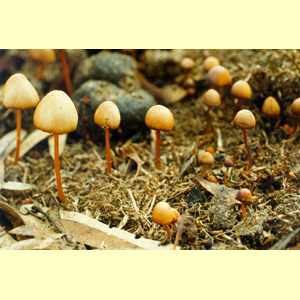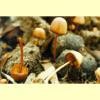
images/Conocybe/ConocybeB.jpg
Small to medium agaric, growing on the ground, litter, mulch or dung, with a rusty to ochre-brown spore print. Pileus pale or brown, rarely white, moist, rarely viscid, hygrophanous. Lamellae adnexed or adnate, rarely free. Stipe central. Partial veil remnants absent. Spores yellow-brown or reddish brown, smooth; germ pore narrow or broad, rarely absent. Cheilocystidia present, lecythiform (widest below, with a capitate apex); pleurocystidia absent. Lamellar trama regular. Pileipellis a hymeniderm. Clamp connections present or absent.
Among brown-spored agarics,
Conocybe is rather similar macroscopically to smaller species of
Cortinarius and to
Galerina and
Tubaria, which differ by having a pileipellis that is a cutis or a trichoderm. Spores are usually warty in
Cortinarius and
Galerina (with a plage in
Galerina).
Cortinarius,
Galerina and
Tubaria also differ in having a cobwebby (
Cortinarius) to membranous (some
Galerina and
Tubaria) partial veil. In addition,
Cortinarius and
Galerina do not grow on dung, and the latter is only occasionally found in mulch. Among brown-spored agarics a hymeniderm is otherwise found only in
Bolbitius (which has a pleated, viscid pileus that rapidly collapses and is often bright yellow), and
Agrocybe (which can have an annulus and/or pleurocystidia, and a pileus that is not translucent-striate). In
Pholiotina an annulus or ring zone (or else an appendiculate pileus margin) is present in the species known from Australia, and where lecythiform (capitate) cystidia are present, the capitate apex is not abruptly seated on a short, distinct neck, as in
Conocybe.
Conocybe Fayod, Ann. Sci. Nat., Bot., sér. 7, 9: 357 (1889).
Five species, more expected. Conocybe apala (= C. lactea), C. crispa, C. rickenii, C. tenera and C. weema.
W.A., S.A., Qld, N.S.W. and Vic. (and probably also N.T. and Tas.).
Mainly in gardens, lawns and disturbed areas, rarely in native forests.
On the ground, or on litter, mulch or dung.
Saprotrophic.
Bougher, N.L. (2009a),
Fungi of the Perth region and beyond: a self-managed field book, Western Australian Naturalists' Club (Inc.), Perth. [
Description and
Illustration of
C. apala]
Breitenbach, J. & Kränzlin, F. (eds) (1995), Fungi of Switzerland. Volume 4. Agarics 2nd part. Edition Mykologia, Lucerne. [Illustration, Description and Microcharacters of 20 European species, including C. lactea, C. rickenii and C. tenera]
Fuhrer, B. (2005), A Field Guide to Australian Fungi. Bloomings Books, Hawthorn. [Description and Illustration of C. tenera]
Grgurinovic, C.A. (1997a), Larger Fungi of South Australia. The Botanic Gardens of Adelaide and State Herbarium and The Flora and Fauna of South Australia Handbooks Committee, Adelaide. [Description and Microcharacters of C. crispa, C. tenera and C. weema and Illustration of C. tenera]
Watling, R. (1982), British Fungus Flora. Agarics and Boleti. 3 / Bolbitaceae: Agrocybe, Bolbitius & Conocybe. Royal Botanic Garden, Edinburgh. [Description, B&W Illustration and Microcharacters of C. apala ( as C. lactea), C. crispa, C. rickenii and C. tenera and numerous other species along with Key to British species]
Young, T. (2000a), Common Australian Fungi, [3rd] revised edn. University of New South Wales Press, Sydney. [Description, Illustration and Microcharacters of C. apala ( as C. lactea)]
Young, A.M. (2005b), A Field Guide to the Fungi of Australia. University of New South Wales Press, Sydney. [Description and B&W Illustration of C. apala ( as C. lactea)]



